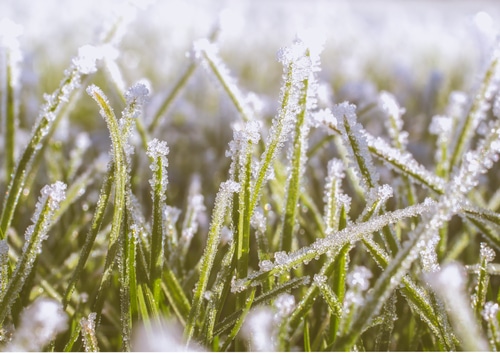

Mowing Right Along
Don’t give up on mowing, just because the weather turns cooler. Until the temperature takes a nosedive, your grass will continue to grow, especially if it’s healthy. Until growth slows or stops, keep mowing to keep the grass at optimum height. Failure to do so could result in matting and snow mold once the long winter months set in.
Fertilize
Your lawn’s grass can still absorb nutrients as the weather turns colder. Feed it well and set it up for success by continuing to fertilize it until the first frost. Since your grass doesn’t get much in the way of nutrients during the winter months, give it what you can while it can still absorb them, so that it has all it needs to come back strong in the spring.
Drain, Drain, Drain
One of the last things you want on your lawn during the winter is standing water. In areas that get heavy snow, this is even more of a risk, as snow creates small dams which hold and pool water on your lawn. Ensure that each part of your lawn can quickly and efficiently drain, starting by ensuring that there aren’t any areas where water pools when it rains. These will be the same areas which puddle during a snowstorm, as well. Fill-in low spots, or even add an underground drainage system, to ensure your lawn can handle any amount of water.
Leave Some Leaves
If you don’t have a mulching attachment for your lawn mower, it is vital to remove as many leaves as possible from your lawn as soon as you can. A layer of leaves can starve your lawn of necessary sunshine and nutrients, and could even cause dead spots. However, if you do have a mulching attachment, take advantage of nature’s free fertilizer, and run over the leaves a few times, chopping them up into tiny pieces. These pieces, as long as they’re not too thick, can remain on the lawn to decay over the winter months, thus releasing all the nutrients they contain.
Leave a Path
When winter does come, and snow starts to fall, make sure that you are quick to shovel paths on driveways and sidewalks to encourage people to use these paths, rather than taking shortcuts across your lawn. Regular foot traffic on snowy grass can cause substantial compaction of the grass, leading to snow mold problems, and unhealthy patches of grass in the spring. By keeping people on the right track, you ensure your dormant grass gets the rest it deserves and is ready to make its grand re-entrance in the spring.
Though there’s not quite as much to do with your lawn once the weather turns colder, the right preparation and effort can ensure that you also have less to do when the warm weather returns.






